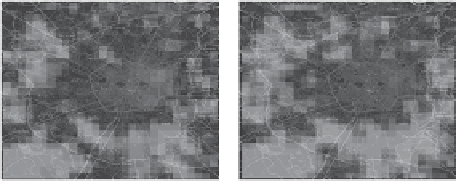Database Reference
In-Depth Information
(a) (b) (c)
Figure 10.11 Distribution of presence on Tuesday, April 3rd, in three contiguous time slots
of 2 hours: (a) from 6 P.M. to 8 P.M.,(b)from8P.M. to 10 P.M., (c) from 10 P.M. to midnight.
An evident hot spot emerges between 8 P.M. and 10 P.M., and disappears afterwards. The
location (immediately west of city center) is that of Stadio Meazza, the main soccer arena.
10.4.4 Extraordinary Events
Extraordinary events have a large impact on mobility. They can include big
planned rendezvous, such as concerts and sport competitions, which set the
destination of many individual trips toward a small area (the event location)
where many people concentrate for the event duration; but also unexpected
events, either natural or human-generated, such as car accidents or floods, that
perturb the regular traffic flow producing (often undesired) concentrations of
vehicles in some specific locations. Even if not known a priori, big events can
be easily detected by localizing exceptionally high concentrations of presence
in specific areas at specific time intervals. The reader may refer to Chapter
8
for a wide presentation of event detection in movement data. Density maps
for stationary cars can be used for visual exploratory analysis of abnormal
concentrations of presence. A density map can be generated by using a spatial
grid and a count of vehicles for each cell for each time interval of interest. For
example, in this analysis we use a grid with cells of size 0.5 km
×
0.5 km and
compute, for each grid cell and for every interval of two hours of each day, the
number of cars that are stationary in the cell.
A sample of the results obtained from Milano2007 is shown in Figure
10.11
.
The location of the hot spot - the main soccer arena and surrounding parking
areas - suggests that a big sport event occurred in such location. It is easy to
check that the Milan A.C. versus Bayern Munich quarter-final match of the
UEFA Champions League took place in the exact location and time, attended by
approximately 77,700 spectators.
3
The detection of such hot spots can be easily
automatized by an iterative procedure that selects every cell
C
and time interval
h
(8-10 P.M. in our case) such that the population of cell
C
during
h
is above
the 90th percentile in the distribution of the population of (
C, h
) over the entire
observation period.
3
Source
http://en.wikipedia.org/wiki/UEFA Champions League 2006-2007




